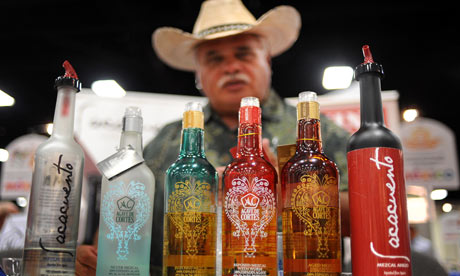
Rodolfo Favila of the Agave de Cortes mescal distillery in Oaxaca, Mexico. Photograph: Bloomberg/Getty
Tequila has firm roots in British drinking culture, typically served in a shot glass with a smattering of salt followed by amnesia and a wince. But it's taken a while for mescal, its stronger and tastier forefather, to emerge from the Mexican countryside. In fact, it's only just become popular in metropolitan Mexico itself.
Mescal is the original agave spirit of which tequila is just one version, and genuinely "artisan" in that the vast majority is still made in dusty-floored family distilleries no larger than a double decker bus. It's made by slowly roasting the agave heart in underground pit ovens (which gives the finished product a smoky flavour), then mashing them to extract the juice which is fermented and distilled. Nothing else is added, the only extra being naturally-occurring yeasts that float in from the outback. Its simplicity means the people who make it think of mescal as more like wine than a spirit, despite it having an average ABV of 50%.
In the southern Mexican countryside they actually call mescal "vino" as it's drunk in wine glasses before, during and after dinner as it has been for centuries. They must have a riot in the wilderness, as this nectar creates a funky buzz - it's uplifting while most alcoholic drinks are depressants. After a while it's even stimulating. The taste is unparalleled ? briny, musty and peaty like some scotch - but the warmth it creates is the main charm.
With all that it's got going for it, it seems strange that it's been the preserve of pastoral old-timers for so long, but the majority of urban Mexicans are aspirational souls who prefer newness to tradition. However, in the last 15 years this mindset has changed and a new generation has embraced its home-grown culture and started shouting about it.
While visitors to Mexico have long known of and enjoyed mescal, about five years ago word hit San Francisco, New York, and then Berlin. Now the drink has come to the UK and a couple of dedicated "mezcalerias" have now opened in London (Qui Qui Ri Qui in Hackney and Wahaca's new Charlotte Street mezcalaria). You can also find it in good Mexican restaurants, although it's by no means spreading like wildfire - importing it requires dealing directly with tiny distilleries, many of whom can't afford the trademark and branding required to actually export.
If you do find yourself heading to a mezcalaria, arrive replete. Always sip it (if you ask for a slammer you're likely to be barred) with a side of chilli-sprinkled orange slices, although roasted grasshoppers or fried larvae are more popular back in Oaxaca. Lengthen the experience with cold Mexican lager and plenty of water. Have no preconceptions when it comes to flavour (Qui Qui Ri Qui's idiosyncratic tasting notes include phrases such as "lighter fuel and barbecue sauce") but you're likely to get smoke and chilli notes.
You can test a mescal's quality by rubbing a bit on the back of your hand - if it goes sticky it contains unnatural sugars. A pure, craft mescal shouldn't even give you a hangover (I can verify this, kind of), and ask to have a good look at the bottle you're drinking from - it will usually be hand signed and plastered with colourful, abstract Zapotec graphics.
Also, get in there quick. UK mescalheads (their term, not mine) are already worried the spirit will go the same way as tequila - watered down and industrialised. Large investment groups are already building huge factories to produce up to 100,000 litres a day ? your average family distillery churns out around 3,000 annually. For an experience that's more Oaxaca coastline than first year frat party, try it very soon.
Source: http://www.guardian.co.uk/lifeandstyle/wordofmouth/2012/nov/21/mescal-the-spirit-of-mexico
uganda the parent trap invisible children kony 2012 space weather sunspots pac 12 tournament sun storm
No comments:
Post a Comment
Note: Only a member of this blog may post a comment.